The painting of Our Lady Consolata, according to tradition, was a gift from Bishop Eusebius to St Maximus, first bishop of the city of Turin, Italy, at the end of the 4th Century. Consolata is a word from the Piedmontese dialect, meaning “Console and Comforter “. Mary, comforted by God, by bringing us Jesus, the great Consolation, becomes a comforter of humanity. This devotion grew and spread rapidly throughout the Piedmont Region, in the north of Italy. In the Middle Ages the city of Turin was bombed, the chapel where the painting was venerated was completely destroyed and it was buried under the rubble.
The story goes that in 1104, a very rich and blind French lord, Jean Ravais, had a dream: he saw a beautiful lady with a boy in his lap, who said to him: “go, to the city of Turin (in Italy), rediscover my painting and you will regain your sight”.
Overcome many difficulties – because no one believed what he was saying – Ravais went to the site of the old chapel and the painting was found. The bishop raised it before the people who exclaimed, “Blessed Virgin Consolata, pray for us!”
And the blind man immediately regained his sight – it was June 20, 1104. The chapel was rebuilt and since then, devotion to Our Lady Consolata has never ceased to grow.
With the process of immigration of the Italians at the end of the 19th century and the beginning of the 20th century, the devotion to Consolata spread throughout the world, but it was especially through Consolata Missionaries, inspired by Father Joseph Allamano, who was the Rector of the Consolata Shrine for 46 years. He (Allamano) entrusted the missionary family to Our Lady Consolata. Allamano contemplated Our Lady to print his traits on his missionaries.

Blessed Joseph Allamano was born on January 21, 1851, in a land fertile of holy men– Castelnuovo d’Asti, now Castelnuovo Don Bosco – in the Piedmont region, northern Italy. He was the fourth of five children. In his early years, he was educated by his mother, Maria Ana Cafasso, sister of St. Joseph Cafasso. He joined the oratory in Turin at a very young age, but opted shortly afterwards for the diocesan seminary. He was ordained a priest in 1873 and soon thereafter appointed spiritual director of the major seminary.
During these years he obtained his doctorate and aggregation to the Theological University of Theology in Turin. In 1880 he was appointed rector of the shrine of Our Lady Consolata in Turin, where he served for 46 years, clearly understanding that every priest is a missionary. Noting the abundance of priests in the dioceses of Piedmont, he founded the Consolata Missionary Institute (Fathers and Brothers) on 29 January 1901 for missions in Africa. In 1910 he founded the Consolata Missionary Sisters.
He died on February 16, 1926 and was beatified by Pope John Paul II on October 7, 1990.
His life and work, as rector of the Consolata Shrine and as a Founder of the two missionary congregations, were fully inspired and marked by the presence and attitudes of Mary, to whom he attributed the success of his apostolic service in the local Church and in the missionary Church.
